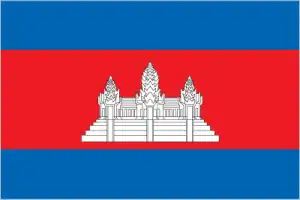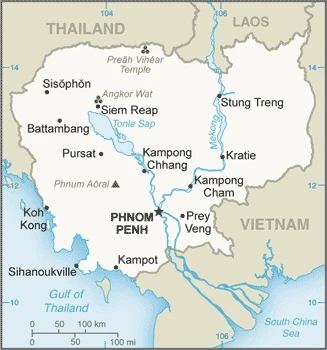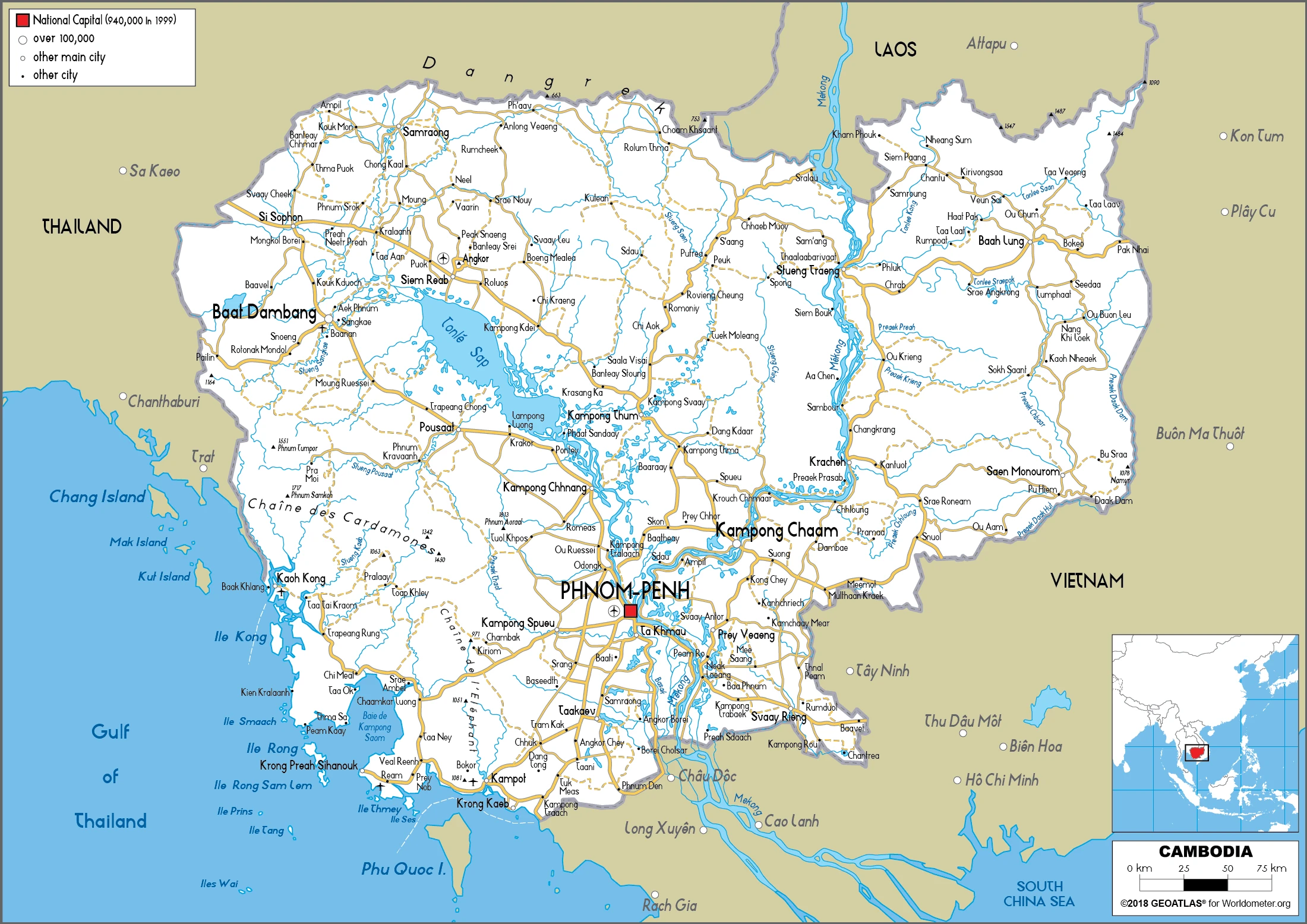Cambodia Google Maps is a site/tool that offers a wide range of map views (topographic, satellite, street view) and navigation options, with little effort on your part, yet efficiently. If you need to plan a trip to a new place like Cambodia, Google maps are available on desktop, mobile, or tablet. This Google maps and information page is dedicated to Cambodia, Southeast Asia (19 countries), showing its location, country facts, details about its capital city Phnom Penh, bordering countries like Laos, Thailand, Vietnam, and plenty of other information which may be interesting when you visit this Southeastern Asian state.
Quick links: Google Maps Cambodia, Phnom Penh Google maps, Driving Directions Cambodia, Printable Road Map.

About Cambodia in a nutshell
- Cambodia has many impressive temples (including Angkor Wat), which date from when the country was the center of the Khmer Empire.
- Conventional short form of the name: Cambodia
- The conventional long form of the name: Kingdom of Cambodia
- Local long form: Preahreacheanachakr Kampuchea (phonetic transliteration)
- Local short form: Kampuchea
- Former name(s): Khmer Republic, Democratic Kampuchea, Peoples Republic of Kampuchea, State of Cambodia
- Etymology: the English name Cambodia is an anglicization of the French Cambodge, which is the French transliteration of the native name Kampuchea.
- The legal system in Cambodia: civil law system (influenced by the UN Transitional Authority in Cambodia) customary law, Communist legal theory, and common law.
- Climate: Tropical. High temperatures throughout the year. Heavy rainfall during MayOctober monsoon.
- The national symbols are Angkor Wat temple, kouprey (wild ox); national colors: red, blue.
- Internet TLD: .kh
Background
Most Cambodians consider themselves Khmers, descendants of the Angkor Empire that extended over Southeast Asia and reached its zenith between the 10th and 13th centuries. Attacks by the Thai and Cham (from present-day Vietnam) weakened the empire, ushering in a long period of decline. The king placed the country under French protection in 1863, and it became part of French Indochina in 1887. Following Japanese occupation in World War II, Cambodia gained complete independence from France in 1953. In April 1975, after a seven-year struggle, communist Khmer Rouge forces captured Phnom Penh and evacuated all cities and towns. At least 1.5 million Cambodians died from execution, forced hardships, or starvation during the Khmer Rouge regime under POL POT. A December 1978 Vietnamese invasion drove the Khmer Rouge into the countryside, began a 10-year Vietnamese occupation, and touched off 20 years of civil war.
The 1991 Paris Peace Accords mandated democratic elections and a cease-fire, which the Khmer Rouge did not fully respect. UN-sponsored elections in 1993 helped restore some semblance of normalcy under a coalition government. Factional fighting in 1997 ended the first coalition government, but the second round of national elections in 1998 led to the formation of another coalition government and renewed political stability. The remaining elements of the Khmer Rouge surrendered in early 1999. Some surviving Khmer Rouge leaders were tried against humanity by a hybrid UN-Cambodian tribunal supported by international assistance. In 2018, the tribunal heard its final cases, but it remains to hear appeals. Elections in July 2003 were relatively peaceful, but it took one year of negotiations between contending political parties before a coalition government was formed. In October 2004, King Norodom SIHANOUK abdicated the throne, and his son, Prince Norodom SIHAMONI, was selected to succeed him. Local (Commune Council) elections were held in Cambodia in 2012, with little violence that preceded previous elections. National elections in July 2013 were disputed, with the opposition – the Cambodia National Rescue Party (CNRP) – boycotting the National Assembly.
The political impasse was ended nearly a year later. The CNRP agreed to enter parliament in exchange for commitments by the ruling Cambodian Peoples Party (CPP) to undertake electoral and legislative reforms. The CNRP made further gains in local commune elections in June 2017, accelerating sitting Prime Minister HUN SENs efforts to marginalize the CNRP before national elections in 2018. HUN SEN arrested CNRP President KEM SOKHA in September 2017. The Supreme Court-dissolved the CNRP in November 2017 and banned its leaders from participating in politics for at least five years. The CNRPs seats in the National Assembly were redistributed to smaller, less influential opposition parties. In contrast, all CNRPs 5,007 seats in the commune councils throughout the country were reallocated to the CPP. With the CNRP banned, the CPP swept the 2018 national elections, winning all 125 National Assembly seats and turning the country into a one-party state. Cambodia has strong and growing economic and political ties with its giant neighbor to the north, China. More than 40% of foreign investment in the country in 2019 came from China, and Beijing has provided over $15 billion in financial assistance since the 1990s. The CPP also partly sees Chinese support as a counterbalance to Thailand and Vietnam and international criticism of the CPPs human rights and anti-democratic record.
Geography
Mostly low-lying basin. Tônlé Sap (Great Lake) drains into the Mekong River. Forested mountains and plateau east of the Mekong.

Located on the Indochinese peninsula in Southeast Asia, Cambodia has emerged from genocide, civil war, and invasion from Vietnam. Tourism has rebounded and is a key income earner.
This state is located in Southeastern Asia, bordering the Gulf of Thailand, between Thailand, Vietnam, and Laos, under the coordinates of 13 00 N, 105 00 E, covering an area of 181,035 sq km with a coastline of 443 km. Cambodia is One and a half times the size of Pennsylvania, slightly smaller than Oklahoma.
Cambodia has 2,530 km of land boundaries in total and borders with (3 nations): Laos 555 km, Thailand 817 km, Vietnam 1158 km.
Mostly low, flat plains, mountains in southwest and north, with Phnum aoral 1,810 m as the highest point of Cambodia, while Gulf of Thailand 0 m as the lowest point, causing a mean elevation at 126 m throughout the country. With a total of 181,035 sq km, Cambodia has 176,515 sq km of land and 4,520 sq km water surface area.
Major water bodies in the country: Tonle Sap – 2,700-16,000 sq km (a freshwater lake), while the significant river is Mekong (shared with China, Burma, Thailand, Laos, and Vietnam) – 4,350 km. The significant watersheds for Cambodia are Pacific Ocean drainage: Mekong (805,604 sq km).
A land of paddies and forests dominated by the Mekong River and Tonle Sap (Southeast Asia’s largest freshwater lake).
The climate in Cambodia is as follows: Tropical, rainy, monsoon season (May to November), dry season (December to April), slight seasonal temperature variation.
When you visit Cambodia, the natural hazards shall be considered: Monsoonal rains (June to November), flooding, occasional droughts.
The following major health-threatening issues shall be considered when visiting Cambodia: degree of risk: very high (2020), bacterial diarrhea, hepatitis A, typhoid fever, dengue fever, Japanese encephalitis, and malaria.
Current environmental issues affecting the Cambodian people: illegal logging activities throughout the country and strip mining for gems in the western region along the border with Thailand have resulted in habitat loss and declining biodiversity (in particular, destruction of mangrove swamps threatens natural fisheries); soil erosion; in rural areas, most of the population does not have access to potable water; declining fish stocks because of illegal fishing and overfishing; coastal ecosystems choked by sediment washed loose from deforested areas inland.
Google Maps Cambodia
The capital and other divisions
Capital city: Phnom Penh found under the coordinates 11 33 N, 104 55 E, applying the time zone UTC+7 (12 hours ahead of Washington, DC, during Standard Time), using the following daylight saving time: none.
Cambodia is a country in Southeast Asia. The capital of Cambodia is Phnom Penh, which is part of the larger city of Siem Reap. Known for its colonial-era French architecture and vibrant nightlife, Phnom Penh has all the ingredients to make it desirable.
Cambodia became independent on 9 November 1953 (from France), and its national holiday is Independence Day, 9 November (1953).
Administrative divisions: 24 provinces (khett, singular, and plural) and 1 municipality (krong, singular, and plural) provinces: Banteay Meanchey, Battambang, Kampong Cham, Kampong Chhnang, Kampong Speu, Kampong Thom, Kampot, Kandal, Kep, Koh Kong, Kratie, Mondolkiri, Oddar Meanchey, Pailin, Preah Sihanouk, Preah Vihear, Prey Veng, Pursat, Ratanakiri, Siem Reap, Stung Treng, Svay Rieng, Takeo, Tbong Khmum municipalities: Phnom Penh (Phnum Penh).
People and society
Devastated by US bombing, then by the Khmer Rouge regime, whose extreme Marxist program killed over a million between 1975 and 1979, Cambodia endured further civil conflict and Vietnamese occupation. The effects are still felt, reflected in the high rates of orphans, widows, and land-mine victims. Fragile stability has lasted since the elections in 1993. King Norodom Sihanouk, a key figure in politics, abdicated in 2004.
The population in Cambodia is 17,304,363 (July 2021 estimate), with an average of 1.34% (2021 estimate) change. That means Cambodia is the No. 70 in the world’s populated rank list. With an average of 26.4 years median age (25.6 years for males and 25.6 years for women), Cambodia ranks No. 153 on the globe’s median age rank list.
The people living in this country are the Cambodian(s) (noun) or Cambodian (adjective) and belong mainly to the following ethnic groups: Khmer 97.6%, Cham 1.2%, Chinese 0.1%, Vietnamese 0.1%, other 0.9% (2013 estimate).
They speak Khmer (official language) 95.8%, minority languages 2.9%, Chinese .6%, Vietnamese .5%, other .2% (2019 estimate) languages and practice the following religions: Buddhist (official) 97.9%, Muslim 1.1%, Christian 0.5%, other 0.6% (2013 estimate).
We can conclude the following about the population in Cambodia: Population concentrated in the southeast, particularly in and around the capital of Phnom Penh. Further distribution is linked closely to the Tonle sap and Mekong rivers. In Cambodia, we are talking about 24.7% (2021) of the total population is living in cities, and most of them reside in the following municipalities: 2.144 million, Phnom Penh (capital city) (2021).
Industry
The economy is heavily aid-reliant, still recovering from civil war. Rubber and timber are exported. Self-sufficient in rice. The garment industry is growing. Land disputes and corruption issues.
Cambodia has experienced strong economic growth over the last decade; GDP grew at an average annual rate of over 8% between 2000 and 2010 and about 7% since 2011. The tourism, garment, construction and real estate, and agriculture sectors accounted for the bulk growth. Around 700,000 people, most of whom are women, are employed in the garment and footwear sector. An additional 500,000 Cambodians are employed in the tourism sector and 200,000 people in construction. Tourism has continued to be overgrown, with foreign arrivals exceeding 2 million per year in 2007 and reaching 5.6 million visitors in 2017. Mining also is attracting some investor interest, and the Government has touted opportunities for mining bauxite, gold, iron, and gems. Still, Cambodia remains one of the poorest countries in Asia, and long-term economic development remains a daunting challenge, inhibited by corruption, limited human resources, high-income inequality, and poor job prospects.
According to the Asian Development Bank (ADB), the population living in poverty decreased to 13.5% in 2016. More than 50% of the population is less than 25 years old. The population lacks education and productive skills, particularly in the impoverished countryside, lacking basic infrastructure. The World Bank in 2016 formally reclassified Cambodia as a lower middle-income country as a result of continued rapid economic growth over the past several years. Cambodia’s graduation from a low-income country will reduce its eligibility for foreign assistance and challenge the Government to seek new sources of financing. The Cambodian Government has been working with bilateral and multilateral donors, including the Asian Development Bank, the World Bank, and IMF, to address the country’s many pressing needs; more than 20% of the government budget will come from donor assistance in 2018.
A major economic challenge for Cambodia over the next decade will be fashioning an economic environment in which the private sector can create enough jobs to handle Cambodia’s demographic imbalance., Textile exports, which accounted for 68% of total exports in 2017, have driven much of Cambodia’s growth over the past several years. The textile sector relies on exports to the United States and European Union. Cambodia’s dependence on its comparative advantage in textile production is a key vulnerability for the economy, especially because Cambodia has continued to run a current account deficit above 9% of GDP since 2014.
Cambodia is rich in the following natural resources: Oil and gas, timber, gemstones, iron ore, manganese, phosphates, hydropower potential, arable land.
The main industrial sectors are typically tourism, garments, construction, rice milling, fishing, wood and wood products, rubber, cement, gem mining, textiles.
The country’s export sectors are particularly strong in clothing, precious metal scraps, trunks/cases, gold, leather footwear (2019), partnering with these nations: the United States 21%, Singapore 8%, Thailand 8%, Germany 7%, Japan 6%, China 5%, Canada 5%, United Kingdom 5% (2019). The export trade resulted in $19.4 billion. Note: Data are in current year dollars (2020 estimate). In a global rank of the export, values resulted in Cambodia’s position of 84.
Land use in Cambodia: 56.5% (2018 estimate) forest, 11.4% (2018 estimate) other.
The arable land area is 22.7% (2018 estimate), and the agricultural land is 32.1% (2018 estimate). Land use for permanent crops 0.9% (2018 estimate), permanent pasture 8.5% (2018 estimate). The sum of the area of the irrigated land is 3,540 sq km (2012).
The main agro-industrial products of Cambodia are cassava, rice, maize, vegetables, sugar cane, soybeans, rubber, oil palm fruit, bananas, pork.
The country typically needs to import: refined petroleum, clothing, gold, cars, flavored water (2019), partnering with the following nations: China 27%, Thailand 25%, Vietnam 15%, Singapore 8% (2019) in a sum value of $23.12 billion. Note: data are in current year dollars (2020 estimate) $25.52 billion. Note: data are in current year dollars (2019 estimate) $21.86 billion. Note: data are in current year dollars (2018 estimate). This sum value on the global ranking list of imports resulted in Cambodia 77.
Cambodia Driving Directions
In this post, you learned about Cambodia, Southeastern Asia, bordering the Gulf of Thailand, between Thailand, Vietnam, and Laos. We published some basic information about its capital Phnom Penh, and the Cambodian nation.
Are you interested in visiting Cambodia and looking for driving directions? Click here to plan your route, or see a printable road map of Cambodia below for an overview of the route network.
Printable map of Cambodia
Did you know about Cambodia?
Cambodia, a country in Southeast Asia, is a beautiful mix of natural and artificial. It has stunning temples and incredible religious architecture. Cambodia is one of the poorest countries in the world because it has no natural resources and is dependent mainly on agriculture and tourism.
The Khmer Empire was one of the most powerful empires ever to exist. After the empire collapsed because of French Colonialism, it split into Cambodia (controlled by Viet-Nam) and Kampuchea (controlled by Thailand).
After virtually visiting Cambodia, you may also be interested in the neighboring countries: Laos, Thailand, Vietnam.
If you liked our Google map and Cambodia information page,
please share it with others or save the link https://www.drivingdirections.net in your bookmarks.

